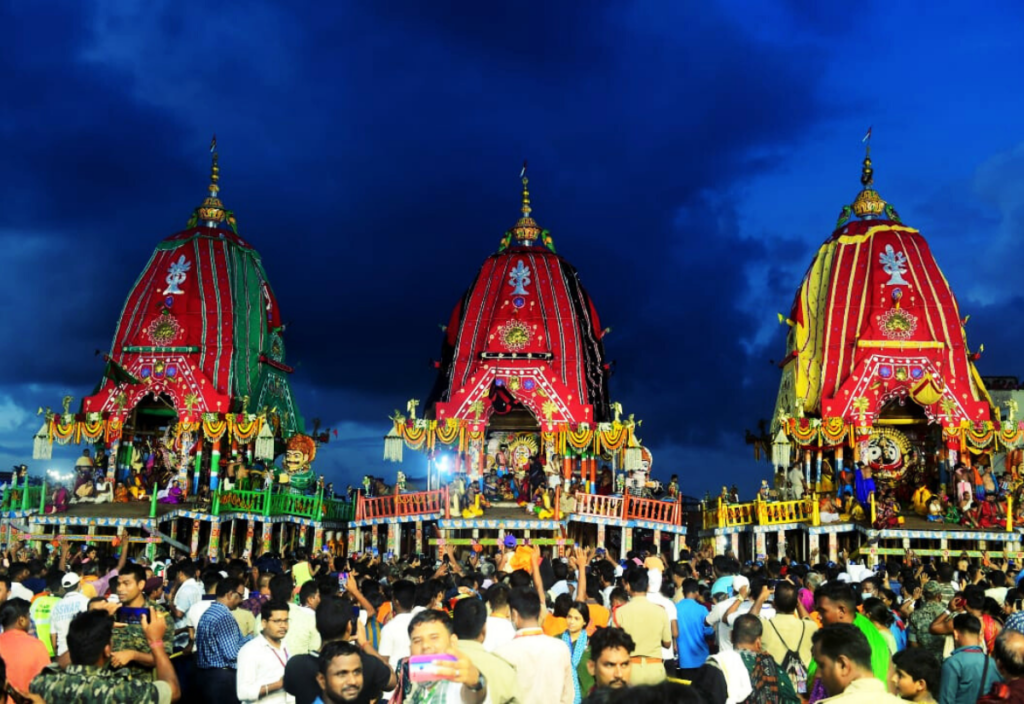Lord Jagannath Rath Yatra 2023 : A Divine Journey
- Vijay Iyer
- June 20, 2023
- 0 Comment
The Lord Jagannath Rath Yatra, known as the Chariot Festival, holds profound significance in Odisha’s socio-cultural landscape. This revered festival brings devotees from various sects and backgrounds to celebrate Lord Jagannath, symbolizing unity, devotion, and spiritual enlightenment. The Rath Yatra transcends caste, color, and creed barriers, embracing the universal message of peace, love, and harmony.
Universalism and Magnanimity of Lord Jagannath Rath Yatra
At the heart of the Rath Yatra lies the universalism and magnanimity of Lord Jagannath. The deity, which typically resides within the temple sanctum, ventures outside to bless devotees of all social statuses, demonstrating that he is accessible to everyone, regardless of their background. Celebrated on the auspicious day of the second day of the bright fortnight of Ashada, the Rath Yatra is observed through specific rituals, fasting, worship, and devotional activities, attracting devotees from far and wide who seek the divine blessings of Lord Jagannath.

Dole tu dolagovindam
Chape tu Madhusudanam
Rathe tu Bamanam drustva
Punarjanmam na vidyate.
(It means the soul attains eternal salvation if one comes across the sight of
Dolagovinda playing holi, Madhusudan enjoying a boat-ride and Jagannath moving in His Chariot.)
Chhera-Panhara and Rajadharma
The festival upholds the concept of Rajadharma, the duty of a king, through the practice of Chhera-Panhara. During this ritual, the Gajapati King, considered the first servitor of Lord Jagannath, humbly sweeps the path of the chariots, symbolizing the king’s commitment to serving both God and humanity. This act strengthens the idea of the king as the first among equals. It highlights the importance of humility and devotion in fulfilling one’s responsibilities.

Love and Affection of Brothers and Sisters
A unique aspect of the Rath Yatra is the portrayal of the deep love and affection between elder brothers and younger sisters. This sentiment is beautifully depicted during the festival, where the claim of wives and other family members is set aside to honor the bond between siblings. This portrayal of familial love adds an endearing dimension to the festival. It reinforces the values of respect and care within families.
The Symbolism of the Chariots
The three majestic chariots used in the Rath Yatra hold profound symbolism. Balabhadra’s chariot, known as Taladhvaja, adorned with blue and red clothes, plows, bunches of corn, and a full pitcher, symbolizes creativity and agriculture, which are fundamental to human prosperity. Subhadra’s chariot, called Darpadalana, marked by twelve wheels representing the twelve months of the year, signifies the balanced qualities essential for a harmonious life. Lord Jagannath’s chariot, Nandighosh, covered in yellow clothes and supported by sixteen wheels, represents the serene and holistic qualities of the Lord, who embodies all sixteen essential qualities for human life. Nandighosh signifies a journey of happiness, devotion, and transcendence.

Influence on Architecture and Artisans
The Rath Yatra has influenced architectural structures beyond the festival itself. The concept of a chariot drawn by horses and driven by charioteers can be observed in the magnificent Sun Temple at Konark. Similarly, remnants of a chariot-like structure in Hampi, Vijayanagar, evoke memories of Jagannath’s grand procession. These architectural resemblances have indirectly strengthened the popularity of the Rath Yatra, especially among the artisan class, who appreciate the craftsmanship and artistic expression associated with the festival.
Reflections on Other Festivals
The influence of the Rath Yatra extends beyond Odisha, finding reflections in other festivals across different regions and religions. The Rukuna Rath of Lord Lingaraja in Bhubaneswar, the Vairabha Yatra in Nepal’s temples, and the Matsyendra Yatra of the Buddhists during the month of Chaitra are remarkable examples of festivals with similarities to the Rath Yatra. Even the ancient Chinese traveler Fa-hi-en documented the car festival of Buddhists in Khotan and Central Asian territories. These diverse cultural expressions showcase Lord Jagannath’s broader significance and cultural heritage.
Enriching Odia Literature and Arts
Lord Jagannath and His abode, Purushottam Kshetra, have inspired poets, writers, singers, and dancers, enriching Odia literature and arts. Renowned figures such as Dinakrushna, Sadananda, Kavisurya Baladev Rath, Gourcharan, Banka Das, Jadumani, Hadidas, Abhimanyu Samanta Singhar, Jayadev, Salbeg, and others have contributed emotionally evocative creations that strengthen the lyrical tradition of Odia literature. Their works capture the significance of the Rath Yatra, elevating it to a timeless and cherished part of Odia culture.
The Lord Jagannath Rath Yatra is a sacred journey that encapsulates unity, devotion, and spiritual transformation. It transcends social barriers and promotes universalism, emphasizing the inclusive nature of Lord Jagannath’s blessings. The festival’s rituals, symbolism, and cultural significance profoundly impact Odisha’s socio-cultural fabric. The Rath Yatra’s timeless message of unity, love, and devotion resonates with devotees from all walks of life, making it a cherished and transformative experience for millions.
Read More: A Journey Through Creative Cultural Heritage – The Living Traditions of Tribal and Folk Paintings in India








